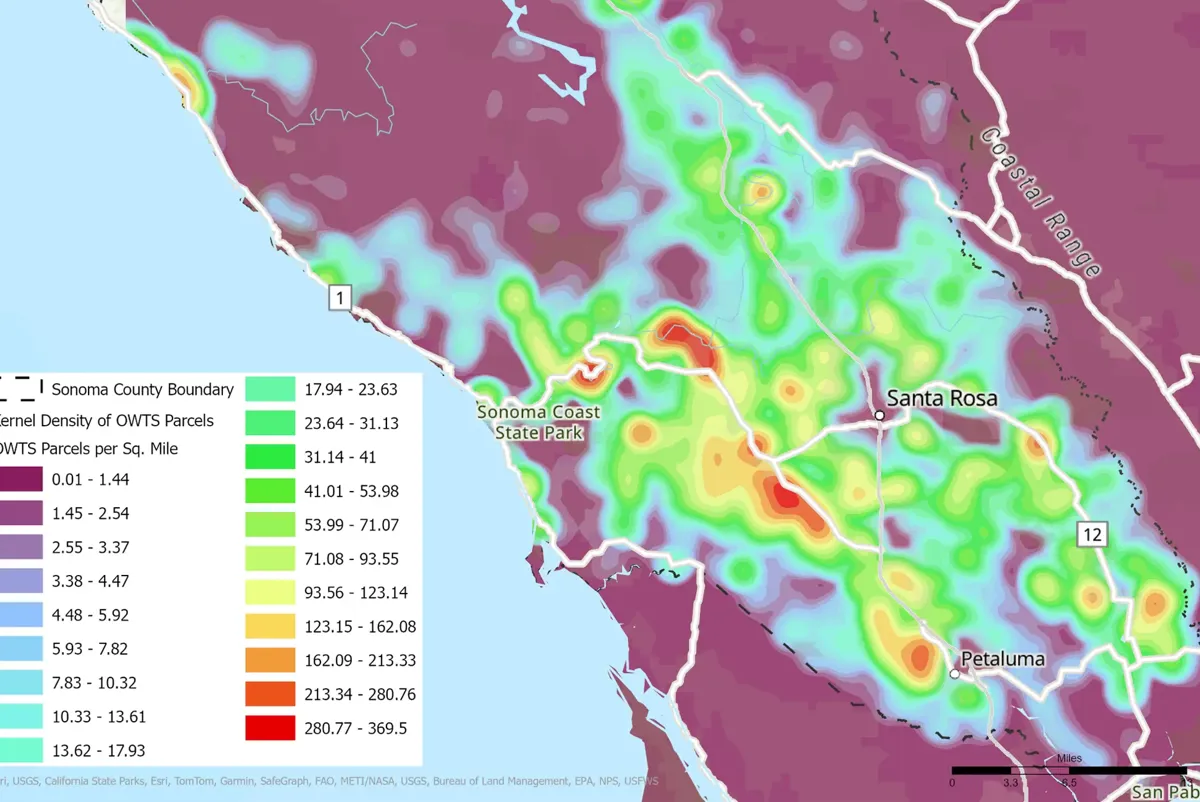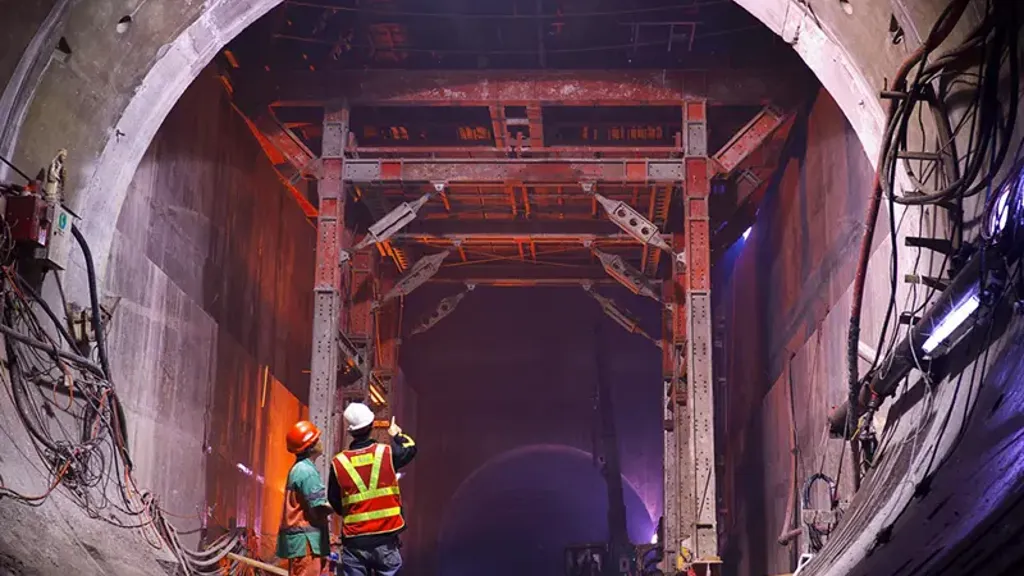Using geospatial and water expertise to inform onsite wastewater treatment system planning
Sonoma County Onsite Wastewater Treatment System Mapping & Analysis Study

Sonoma County, in Northern California, contains over 36,000 known and suspected septic systems. The County of Sonoma was motivated to increase understanding of the locations of existing septic systems, identify opportunities and challenges related to system infrastructure and management, and analyze selected communities to provide high-level suggestions that may address their wastewater needs.
Arup partnered with the County of Sonoma to create a report detailing the locations of septic systems across Sonoma County, where there are existing wastewater treatment plants, opportunities for connecting locations to plants, and more. The information from this report was then compiled into an information hub hosted on Sonoma County’s website, which includes an interactive web-based tool developed by Arup.
Onsite wastewater treatment systems (OWTS), also called septic systems, are useful and necessary means to treat wastewater for residents at locations that are removed from centralized treatment systems. When properly sited, designed, operated, and maintained, septic systems treat domestic wastewater to reduce its polluting impact on the environment and protect public health. However, if poorly maintained or improperly sited, septic systems can impact the environment and its surrounding communities.
The information collected by this study will help inform decisions about wastewater infrastructure and management across the county, including how to support and address the wastewater needs of communities. Well managed and effective wastewater treatment benefits both the environment and communities.
Utilizing digital expertise to conduct data-driven analyses
To inform the interactive mapping tool, Arup’s digital experts mapped the location of septic system clusters and identified their density. The team developed a methodology that used recent permits, land ownership, and land use patterns to identify the suspected locations for septic systems.
To develop a geospatial tool tailored to the client’s needs, Arup mapped the analysis findings utilizing GIS software. Beyond simply presenting a map, the hub tool was used to conduct geospatial analysis, offering an opportunity for data-driven decision-making.
Arup then analyzed selected communities across the county. Different communities and settlements each have their own wastewater system and management needs, so communities require localized interventions as opposed to a single countywide solution. From this analysis, community clusters with shared characteristics can be evaluated together to recommend the best solutions for improvement. Arup’s findings can be used by the County of Sonoma to work closely with communities and develop collaborative solutions.


Map showing density of septic systems across the county as number of septic systems per square mile
Understanding the factors impacting communities’ wastewater management
Helping communities identify alternatives to septic systems requires consideration of governance and technical factors to help suggest locally appropriate and comprehensive interventions. Arup looked at several factors, including opportunities to utilize shared or community septic systems, the impacts of wells on opportunities, locations of utility corridors and roads, impacts of population density, geographic boundaries, economic factors, and opportunities of recycling septic system wastewater.
Determining where septic systems are located is crucial, as the proximity to groundwater and water bodies can impact water quality. If large concentrations of septic systems are located close to a body of water, the water does not have time to be treated through the soil and may not be clean enough as it enters the water body. In addition to benefiting the environment, well managed and effective wastewater treatment governance carries impact for communities.
Using prior local studies, Arup’s wastewater experts used density thresholds to characterize parcels as low, medium, or high density for septic systems. Additionally, Arup’s water experts performed a literature review investigating existing documentation, regulations, County codes, and prior studies to uncover opportunities to increase access to wastewater infrastructure, community solutions, or support. This includes exploring community-based wastewater alternatives to septic systems, such as connections to sewer, community or shared systems, or other alternative wastewater treatment technologies.
The team then offered a detailed methodology to the County to help prioritize clusters and identify those that would offer greater impact to communities and water quality, considering characteristics such as density, disadvantaged community status, and technical and governance opportunities and constraints. Arup’s advice incorporates local community and stakeholder feedback. This in-depth analysis and methodology will allow a large, countywide challenge to be systematically evaluated.
Intertwining digital and water services to develop a comprehensive, informative tool
With the nature of this project, Arup took advantage of the deep technical expertise of both the firm’s Digital and Water teams, who collaborated to build an interactive tool that will help inform the County’s future projects. The creation of this tool involved the development of a user-friendly mapping and information hub to inform clients and communities and help them analyze the wastewater management and infrastructure landscape on a larger scale. The collaborative design of the tool brought an integrated approach that would not have been possible without this partnership between teams.
This project takes a significant step forward in our ability to understand and examine our existing wastewater infrastructure and management.
Michael Makdisi
Former Analyst & Ombudsman, Climate Action and Resiliency Division, County of Sonoma
What we delivered
-
Identified locations of septic systems throughout Sonoma County to determine opportunities for alternatives
-
Combined geospatial and software development expertise with water-focused insights to develop an interactive mapping tool
-
Categorized communities based on governance and technical constraints to help suggest locally appropriate and comprehensive interventions
Get in touch with our team
Projects
Explore more waste water management projects

Using AI to uncover and prioritise Inflow and Infiltration reduction opportunities
Addressing Inflow and Infiltration with Severn Trent Water in Gloucester, United Kingdom

Designing underground tunnels for Singapore’s water treatment network
Deep Tunnel Sewerage System Phase 2 T-08 and tunnels from Tuas Water Reclamation Plant, Singapore

Hong Kong’s biggest flood prevention project
Hong Kong West Drainage Tunnel, Hong Kong

A nature-based approach to combined storm overflows
Pont-y-felin Lane, United Kingdom
Get in touch with us
If you'd like to speak to one of our digital experts about any of the issues raised on this page or a potential collaboration then please get in touch by completing the form.

